
Nichols Field was a U.S. military airfield located south of Manila in Pasay and Parañaque, Metro Manila, Luzon, the Philippines. The complex is located at Andrews Avenue by the north, Domestic Road by the west, NAIA Road and Ninoy Aquino Avenue by the southwest, Multinational Avenue by the south, South Luzon Expressway and the Metro Manila Skyway by the east, and Sales Street by the northeast.
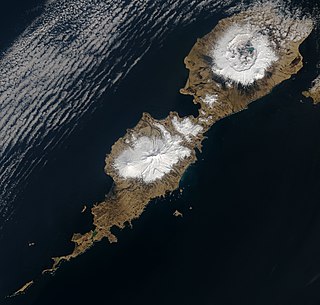
Umnak is one of the Fox Islands of the Aleutian Islands. With 686.01 square miles (1,776.76 km2) of land area, it is the third largest island in the Aleutian archipelago and the 19th largest island in the United States. The island is home to a large volcanic caldera on Mount Okmok and the only field of geysers in Alaska. It is separated from Unalaska Island by Umnak Pass. In 2000, Umnak was permanently inhabited by only 39 people and by 2010, around 18, placing the settlement of Nikolski in difficulty and its school was closed.

The Aleutian Islands campaign was a military campaign fought between 3 June 1942 and 15 August 1943 on and around the Aleutian Islands in the American Theater of World War II. It was the only military campaign of World War II fought on North American soil.

Eareckson Air Station, formerly Shemya Air Force Base, is a United States Air Force military airport located on the island of Shemya, in the Alaskan Aleutian Islands.

The Eleventh Air Force (11 AF) is a Numbered Air Force of the United States Air Force Pacific Air Forces (PACAF). It is headquartered at Joint Base Elmendorf–Richardson, Alaska.

The Alaskan Air Command (AAC) is an inactive United States Air Force Major Command originally established in 1942 under the United States Army Air Forces. Its mission was to organize and administer the air defense system of Alaska, exercise direct control of all active measures, and coordinate all passive means of air defense. In addition, the command also supported Strategic Air Command elements operating through and around Alaska. It was redesignated Eleventh Air Force on 9 August 1990 and, concurrently, status changed from a major command of the United States Air Force to a subordinate organization of Pacific Air Forces.

Marks Air Force Base is a former United States Air Force facility located two nautical miles (4 km) west of the central business district of Nome, a city in the Nome Census Area of the U.S. state of Alaska. It was named in honor of Major Jack S. Marks, a United States Army Air Forces pilot based at Ladd Army Airfield who died when his aircraft was shot down over the Aleutians in July 1942. Following its closure, it was redeveloped into Nome Airport.

The 343d Wing is an inactive United States Air Force unit. Its last assignment was with Pacific Air Forces at Eielson Air Force Base, Alaska, where it was inactivated on 20 August 1993. The unit was formed at Eielson as the 343d Composite Wing and activated in October 1981 to replace the 5010th Combat Support Group. It operated both fighter and forward air control aircraft. In 1991, it also became the administrator for periodic Exercise Cope Thunder operations, which moved to Alaska from the Philippines after the eruption of Mount Pinatubo resulted in the evacuation of units from Clark Air Base When the wing was inactivated, it was replaced at Eielson by the 354th Fighter Wing.
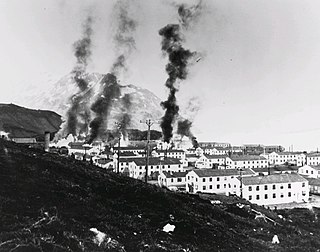
The Battle of Dutch Harbor took place on 3-4 June 1942, when the Imperial Japanese Navy launched two aircraft carrier raids on the Dutch Harbor Naval Operating Base and U.S. Army Fort Mears at Dutch Harbor on Amaknak Island, opening the Aleutian Islands campaign of World War II. The bombing marked the first aerial attack by an enemy on the continental United States and was the second time in history that the continental U.S. was bombed by someone working for a foreign power, the first being the accidental bombing of Naco, Arizona, in 1929.

Cape Field at Fort Glenn was a military site significant for its role in World War II. It consists of Fort Glenn, an airfield of the United States Army Air Corps later renamed Cape Air Force Base, and the adjacent Naval Air Facility Otter Point, both located on Umnak Island in the Aleutian Islands of southwestern Alaska. The site was listed on the National Register of Historic Places and declared a National Historic Landmark in 1987.
During World War II, Alaska was a major United States Army Air Forces (USAAF) location for personnel, aircraft, and airfields to support Lend-Lease aid for the Soviet Union. In addition, it was in Alaska that the Empire of Japan bombed and seized United States soil and as a result the USAAF was actively engaged in combat operations against them.
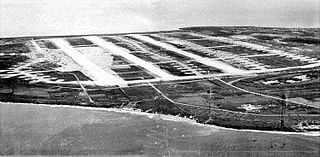
North Field was a World War II airfield on Tinian in the Mariana Islands. Abandoned after the war, today North Field is a tourist attraction. Along with several adjacent beaches on which U.S. Marines landed during the Battle of Tinian, the airfield is the major component of the National Historic Landmark District Tinian Landing Beaches, Ushi Point Field, Tinian Island.

Thornbrough Air Force Base is a former facility of the United States Air Force in Cold Bay, Alaska. Following its closure, it was redeveloped into Cold Bay Airport.

Lakeland Army Airfield, was a World War II United States Army Air Force located 5.3 miles southwest of Lakeland, Florida. From 1960 to 2017 it was Lakeland Linder Regional Airport. In 2017 it was renamed Lakeland Linder International Airport.
Amchitka Air Force Base is an abandoned Air Force Base located on Amchitka, in the Rat Islands group of the Aleutian Islands in southwest Alaska.
Alexai Point Army Airfield is an abandoned World War II airfield with two runways laid across Alexai Point on Attu Island, Alaska. The remains of the Seabee built airbase are located about 4 miles east of the closed Casco Cove Coast Guard Station, directly across Massacre Bay.

Elmendorf Air Force Base is a United States Air Force (USAF) facility in Anchorage, Alaska. Originally known as Elmendorf Field, it became Elmendorf Air Force Base after World War II.

The 344th Fighter Squadron is an inactive United States Air Force unit. Its last assignment was with 343d Fighter Group stationed at Shemya Army Airfield, Alaska Territory.
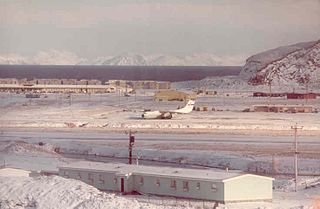
Naval Air Facility Adak, was a United States Navy airport located west of Adak, on Adak Island in the U.S. state of Alaska. After its closure in 1997, it was reopened as Adak Airport. The facility was designated a National Historic Landmark for its role in World War II, although most of its elements from that period have been demolished or lie in ruins.
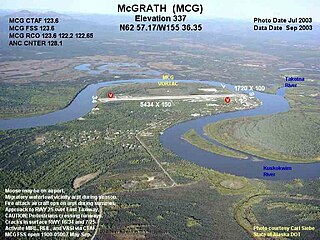
McGrath Army Airbase is former United States Army airbase located in McGrath, a city in the Yukon-Koyukuk Census Area of the U.S. state of Alaska.























